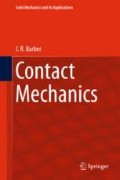Abstract
Filon (1903) (Philosophical Transactions of the Royal Society of London, pp. 63–155 [201], 1903) investigated the state of stress in an infinite elastic layer of thickness 2h subjected to equal and opposite concentrated forces on the two faces, as shown in Fig. 11.1a. He showed that the normal traction on the plane of symmetry [the dashed line in Fig. 11.1a] becomes tensile for \(|x|\!>\!1.35\, h\), where x is measured from the line of action of the forces. He deduced correctly that if a single layer of thickness h were pressed against a frictionless rigid plane, the layer must lift off from the plane at the edges, as shown in Fig. 11.1b.
Access this chapter
Tax calculation will be finalised at checkout
Purchases are for personal use only
Author information
Authors and Affiliations
Corresponding author
Problems
Problems
1. An infinite uniform straight beam of flexural rigidity EI and negligible weight rests on a unilateral elastic foundationFootnote 2 of modulus k. In other words, the beam is not bonded to the foundation, which can therefore transmit compressive tractions only. A force F is now applied to the beam as shown in Fig. 11.10, causing contact in the region \(-a\!<\!z\!<\!a\) and separation elsewhere.
Show that a is independent of F and find its value.
2. A rigid non-conducting half-plane slides over an elastic conducting half-plane at speed V. The normal contact force is P and the coefficient of friction is f. The work done against friction is converted to heat which is conducted into the conducting body. By considering the dimensions of the governing parameters, show that the semi-width a of the contact region in the steady state must take the form
where \(K,\alpha , E\) are, respectively, the thermal conductivity, thermal expansion coefficient and elastic modulus of the deformable half-plane, and C is a dimensionless constant that depends only on Poisson’s ratio.
3. Suppose the non-conducting half-plane in Problem 2 is replaced by a slightly rounded body, leading to a quasi-Hertzian contact problem. How would you expect the semi-width of the contact area to vary with the normal force P. In particular, what happens when P is very large?
4. A steel pin of diameter 20 mm fits in a hole in a steel component with a diametral clearance of \(0.1\!\,\pm \,\!0.02\) mm, depending on manufacturing tolerances. If the axial length of the contact is 50 mm and the pin transmits a radial force of 100 kN, estimate the maximum contact pressure. How sensitive is your result to variability within the tolerance bands? Would an estimate based on zero clearance be sufficient for design purposes? [for steel, \(E\!=\!210\) GPa, \(\nu \!=\!0.3\).]
5. A cylindrical pin is an interference fit in a hole in a body of the same material. Separation just starts when the force \(P\!=\!P_1\) and exactly half of the interface is separated (\(\psi \!=\!\pi /2\)) when \(P\!=\!P_2\). Show that
and find the corresponding ratio as a function of \(\alpha ,\beta \) for the case where the materials are dissimilar.
6. Figure 11.11 shows a rigid square block of side a clamped between two elastic layers. Each of these layers can be approximated as Winkler foundations of modulus k—i.e. the contact pressure \(p(x)\!=\!ku(x)\), where u(x) is the local indentation.
Initially, the layers are pressed together until the contact pressure is uniform and equal to \(p_0\). They are then held in this position, whilst a moment \(M_0\) per unit length [into the paper] is applied to the block as shown in the figure.
-
(i)
Show that if \(p_0\!=\!0\) implying that the block just fits between the undeformed layers, the length of the contact region b on each surface is the same for all positive values of \(M_0\).
-
(ii)
For \(p_0\!>\!0\), show that b depends only on the ratio \(M_0/p_0\) and that it tends to the value obtained in part (i) as this ratio increases.
Rights and permissions
Copyright information
© 2018 Springer International Publishing AG
About this chapter
Cite this chapter
Barber, J.R. (2018). Receding Contact. In: Contact Mechanics. Solid Mechanics and Its Applications, vol 250. Springer, Cham. https://doi.org/10.1007/978-3-319-70939-0_11
Download citation
DOI: https://doi.org/10.1007/978-3-319-70939-0_11
Published:
Publisher Name: Springer, Cham
Print ISBN: 978-3-319-70938-3
Online ISBN: 978-3-319-70939-0
eBook Packages: EngineeringEngineering (R0)


